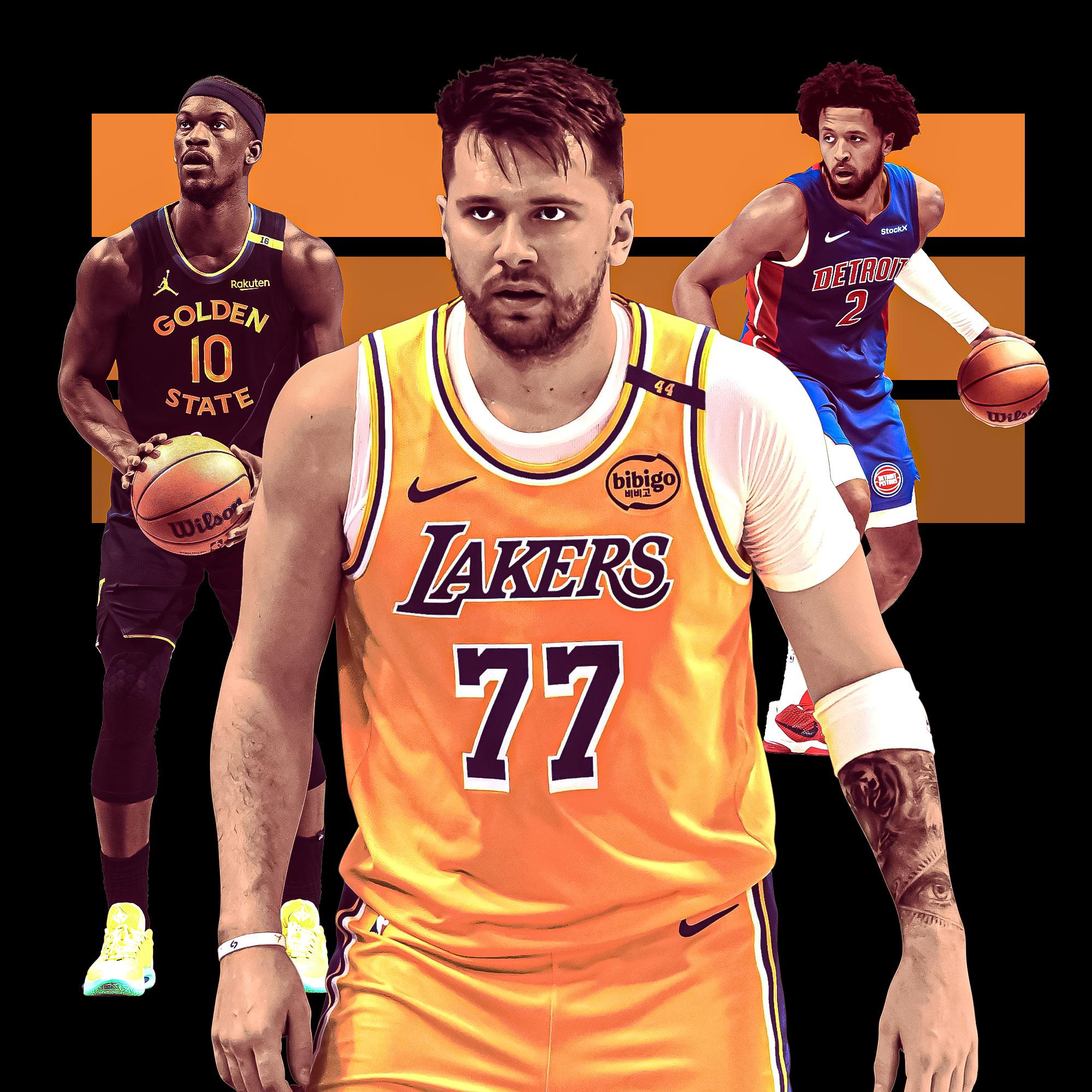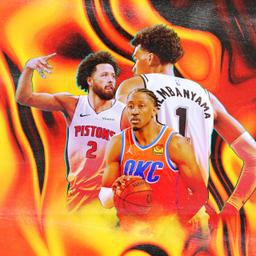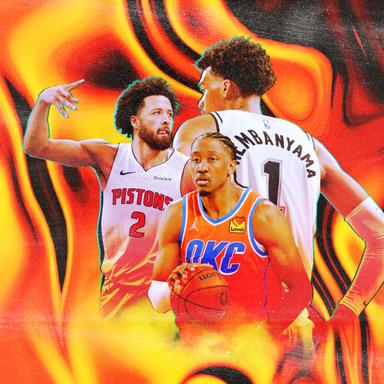Chet Holmgren lay on the hardwood, curling onto his side, wincing in pain. The Paycom Center in Oklahoma City fell silent. Just seconds earlier, Holmgren had exploded to meet Andrew Wiggins at the rim, attempting to block the Warriors forward’s layup. After contact, he landed awkwardly on his hip and had to be carried to the locker room.
It was a play that should have changed the trajectory of Oklahoma City’s season. Holmgren was in the midst of a monster breakout for a rising Thunder team that looked ready to contend for a championship. But when it was announced that Holmgren would be sidelined for at least two months with a pelvic fracture, the Thunder were suddenly centerless. The other two bigs on their roster, Jaylin Williams and free agent signee Isaiah Hartenstein, were already out with injuries.
Thunder coach Mark Daigneault knew the right man for the job: Jalen Williams.
“He sees challenges as opportunities instead of excuses,” Daigneault says. Though J-Dub stands at just 6-foot-6, Daigneault believes the 23-year-old breakout star can do just about anything on a basketball court. In addition to one of the most versatile skill sets in the NBA, Williams has a 7-foot-2 wingspan, which is so unfathomable that, according to one of his college coaches, it had to be measured 11 times at the NBA combine just to be sure.
[Jalen’s] greatness is the cumulative effect of all of the things that he does. Basketball is a complex game. You can’t be good at just one thing and be a great player, but he’s good at everything.Mark Daigneault
For Williams’s part, he didn’t hesitate when he was asked to fill in. His entire life has been about embracing challenges, proving people wrong. “I still have that mentality,” he says. Williams remembers every slight and every detour on his road to the NBA, from being under-recruited out of high school to attending the smaller school of Santa Clara University to flying under the radar of many NBA scouts. “It’s just something I still don’t forget,” he says. “Actually, that’s still a very prominent thing I think about.”
When Jalen moved to center, his father, Ron, a lifelong Lakers fan, told him a story: Game 6 of the 1980 Finals. Lakers vs. Sixers. Kareem Abdul-Jabbar had sprained his ankle the previous game and was sidelined. With a championship on the line, the Lakers needed their 6-foot-9 rookie point guard, Magic Johnson, to fill in. It would be a daunting task guarding Philadelphia’s 6-foot-11 skyscrapers, Caldwell Jones and Darryl Dawkins—not to mention superstar forward Julius Erving. On the road. But Magic met the moment with an all-time performance, dropping 42 points, five rebounds, and seven assists in a 123-107 victory that clinched the championship.
That parable of positionless basketball has become something of a blueprint for Williams. Daigneault calls him a “Renaissance man” and an “artist.” “You really cannot find a weakness in his game,” Daigneault says. J-Dub can score at all three levels, play off the ball, set up teammates, defend positions 1 through 5, pickpocket ball handlers, and sky for out-of-nowhere blocks. He takes everything extremely seriously—yet moves with joy and ease, as if he’s playing pickup. He has a be-quick-but-don’t-hurry tempo to his game and an elite basketball IQ.
“His greatness is the cumulative effect of all of the things that he does,” Daigneault says. “Basketball is a complex game. You can’t be good at just one thing and be a great player, but he’s good at everything.”
Williams has taken his do-it-all brand of basketball to another level in his third season. He’s averaging career highs in points (20.7), rebounds (5.7), and assists (5.2) and building a case to make his first All-Star team.
More importantly, he’s become the X factor on the top team in the Western Conference. “He’s been special for us and is a big reason why we are where we are,” Shai Gilgeous-Alexander says. “He just does whatever it takes to win.”
Williams’s versatility not only helped the Thunder weather injuries to their frontcourt this season, but it also enabled their ultra-modern winning formula, which marries a near-unguardable five-out offense with a historically great defense. Even in an NBA that is more skilled than ever, Williams’s multidimensionality stands out.
“You apply that to the rest of the league,” Daigneault says, “and it’s like, all right, who else checks all these boxes? There’s a list probably, but it’s very short.”
That’s why Daigneault trusted Williams to hold down the 5 and why J-Dub played brilliantly in that role during the time between Holmgren’s injury and Hartenstein’s return. In fact, J-Dub may find himself pressed into service once more, as Hartenstein is set to miss at least a week with a calf strain.
“He did an amazing job for us,” Holmgren says.
“The best players, the more situations you put them in, the more they impact the game,” Holmgren says, adding: “I think it just speaks to him being a winning player and being willing to do whatever it takes.”
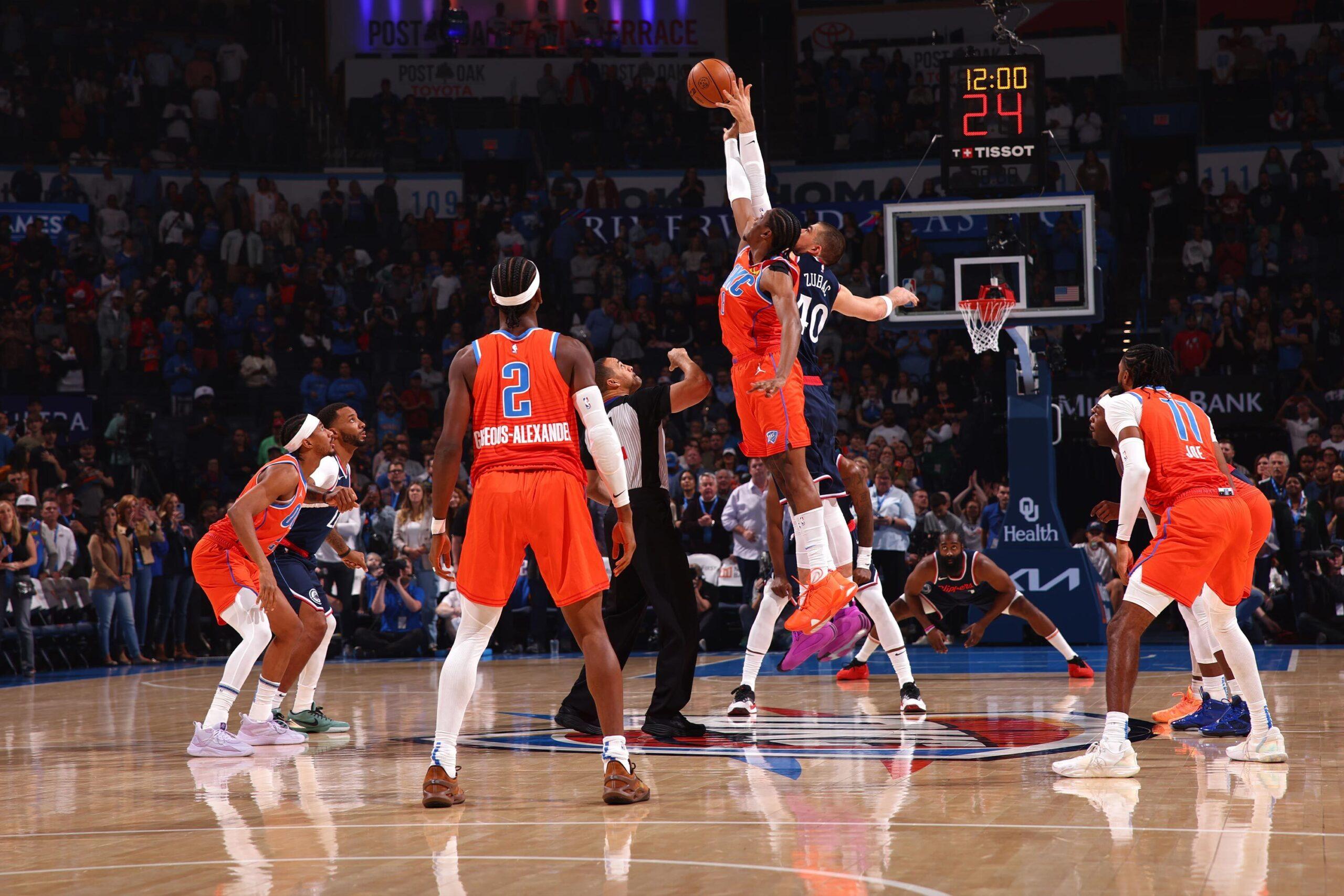
Before his first start at center, Williams approached the opening tipoff as a challenge within the challenge. He had hardly ever done it before.
The Thunder were playing the Clippers, and Williams found himself sharing the jump-ball circle with Ivica Zubac, L.A.’s 7-foot center and one of the most physical bigs in the league. Williams lost the tip, but, in something of a preview of the game to come, he made Zubac work for it. “I feel like I was shocking the bigs a little bit by even jumping,” says Jalen, who finished with 28 points, eight rebounds, and six assists in a 134-128 win that night.
During J-Dub’s time as a big, opposing centers would often go right at him, posting him up, trying to take advantage of the perceived mismatch. That fired Williams up even more. “You have to take defense personal,” Williams says. It wasn’t easy getting beaten up in the paint and learning a new position in OKC’s scheme—all while maintaining stamina on offense as OKC’s second-leading scorer (behind Gilgeous-Alexander).
Yet Williams takes pride in guarding players who are bigger and taller than he is, from 6-foot-11 Giannis Antetokounmpo to 7-foot-3 Victor Wembanyama. “I feel like there’s probably three or four people in the NBA that I think get that assignment. And I think that’s being generous,” Williams says. “I think I’ll throw Kawhi [Leonard] in there, maybe, as one, and he’s not even playing. … Not everybody gets that assignment, so I try and just accept the challenge.”
Williams brims with confidence, but it’s not arrogance. He’s had to believe in himself because for so long, few did. It’s an attitude that stems from being shorter than his peers when he began playing at 5 years old. “I probably had little man syndrome,” he says. “I’m not going to say I had haters at 8 years old and people were like, ‘You’re not going to make it,’ [but] just from an attitude standpoint, I had a fiery, prove-you-wrong attitude.”
That mentality continues to drive Williams as he establishes himself as one of the most promising young players in the NBA. “I feel like I had a really good rookie year that got swept under the rug,” he says, even though he finished second in Rookie of the Year voting. He finds things like this to motivate himself, perpetually trying to improve. “I’ve seen the way that he’s progressed in his short time here,” Holmgren says. “When you are around him every day, you see how hard he works.”
That’s also one of the reasons Williams has found a home among OKC’s tenacious, dogged wing corp. With J-Dub, Lu Dort, Alex Caruso, Cason Wallace, and even SGA, the Thunder can unleash basketball hell on opposing ball handlers. Though they’re one of the smaller teams in the NBA, especially in the frontcourt, they make up for it by forcing tons of turnovers—and by utilizing J-Dub’s versatility to great effect.
“He allows us to really do anything out there,” Gilgeous-Alexander says of Williams. “He allows us to play multiple coverages. He allows us to switch, he allows us to play at the basket, he allows us to show. He allows us to do so many things that usually, when you’re a guard, you have no choice but to switch because you’re small. That’s not the case with him just because he’s so versatile defensively and so good around the rim.”
Another reason Williams has meshed so well is the time he’s spent with SGA, his backcourt mate and frequent summer workout partner dating back to his rookie year. “I just tried to give him as much of the game that I had, just the ins and outs, the tricks of the trade—just the things that aren’t on the script as a rookie,” SGA says. “He obviously took those and ran with it and is a player today because of it, and that’s all credit to him and his work ethic and his mentality.”
The healthy competition of those workouts spurs Williams to this day. “You’re trying to one-up [Shai] a little bit,” he says. “I bet he’s working out right now.”
One memory in particular comes to Williams’s mind: December 27, 2023, when Williams, in just his second season, scored a career-high 36 points against the Knicks. He dazzled, nailing impossible jumpers, including a pair of clutch 3-pointers in the fourth quarter, playing with the ease of a seasoned vet. After the game, though, Gilgeous-Alexander pointed out that he had missed a few free throws.
“That could have been 40 tonight,” Williams remembers SGA telling him.
The two laughed, but Gilgeous-Alexander was serious. “Shai makes me more competitive because he’s ultracompetitive,” Williams says. Of playing the 5, he adds, “He’s pushing me to embrace the challenge. I think hearing that from him is good for me because it makes you not get comfortable.”
I probably had little man syndrome. I’m not going to say I had haters at 8 years old and people were like, ‘You’re not going to make it,’ [but] just from an attitude standpoint, I had a fiery, prove-you-wrong attitude.Jalen Williams
Together, SGA and J-Dub are making sure nobody on the Thunder feels too comfortable, even as they add more distance between themselves and the rest of the Western Conference. Last season, OKC became the youngest team to earn a no. 1 seed and win a playoff series, but it was ultimately knocked out in the second round by the eventual West-winning Mavericks. One year later, the NBA’s fourth-youngest roster is intent on proving it’s ready. “I feel like our team doesn’t get a lot of the credit, which I think is another push,” Williams says. “As a team, I feel like we have a lot of good players that don’t really get that push because we’re a smaller team, I guess, or a smaller market.
“That definitely adds to the chip on our shoulder,” Williams says. “It definitely adds to mine.”
Williams can pinpoint the specific game that changed the trajectory of his basketball career. He was 15, maybe 16, one of the younger players at a giant AAU tournament in Orange County. Certain colleges were aware of him, but Williams wasn’t heavily recruited and was largely seen as undersized.
That day, Jalen was playing on a court in the most tucked-away corner of the complex. “Court 87,” he recalls, describing what he called the “back alley” of the giant California gym hosting the tournament. That part of the complex was largely devoid of college coaches—at least until a chance encounter with Jason Ludwig.
Ludwig, an assistant coach at Santa Clara, was on his way to the exit, but he had to walk past court 87 to get there. As he walked by, Williams’s AAU coach, Paul Suber, called to him: “Hey, coach, you’ve got to stay and watch my young kid Jalen Williams.”
Ludwig and Suber had a relationship, and Ludwig recognized Williams’s name, so he sat down to watch. “He had a good skill level, a good IQ,” Ludwig says. “He had a good-looking shot, but his arms and legs were still too big for his body. He wasn’t the fastest or the most explosive, but his feet were huge, and [he had] long arms. And I was like, ‘OK, this kid maybe has some potential.’”
Ludwig and the Santa Clara staff began recruiting him, but not because they knew he’d become an NBA star—no one thought that. “I’d be lying to you if I told you that when I saw him when he was 15 that I thought, ‘Oh, that guy’s an NBA player.’ I had no idea,” Ludwig says. Jalen didn’t even dunk in a live game until his senior year of high school. But he had a unique skill set and drive, inspired by his parents, Ron and Nicole.
Ron was active in the Air Force for about 24 years, working as a jet engine mechanic and in logistics. Nicole spent 12 years in the Air Force, including time as a medical professional working in hospitals and clinics. They also both played hoops. Coming out of high school, Nicole had three full-ride basketball scholarships but opted to instead pursue her dream of joining the Air Force, where she continued to play on her base’s coed teams. Ron played there as well and was named to the men’s All–Air Force team.
Ron and Nicole instilled two important qualities in Jalen and his younger brother, Cody, now a rookie for the Utah Jazz: discipline and a love of basketball.
Jalen cautions against any stereotypes of military families, though discipline was something the kids learned early. Nicole once pulled Jalen out of school—as a high school sophomore—for not making his bed. Academics were a priority. So was faith. His parents always reminded him and Cody: “You’re not just athletes.” But Ron and Nicole also made space for Jalen and Cody to pursue their dreams, encouraging them to “never settle.” “I never told them they had to be perfect, but just don’t be content,” Nicole says. “Just keep pushing yourself.”
As for hoops, the family enjoyed regular games of two-on-two: kids vs. parents. Despite growing up in Arizona, Jalen became a Lakers fan like his father, who is from Los Angeles. The only time the family didn’t have dinner together at the table was when a Lakers game was on. Jalen’s favorite player was Kobe Bryant, whose mentality to outhustle, outsmart, out-anything to win captivated him. “I didn’t watch anybody else,” Williams says.
It would be silly to put a ceiling on how good [Jalen] can be.Shai Gilgeous-Alexander
As Jalen grew older, he struggled to gain the attention of recruiters in such a hoops hotbed. He was too small. As a kid, he once asked Nicole about one of his grandmothers: “How tall did you say Mima was? Am I going to be like her?” (She was 4-foot-11.) “Just having the doubt is what was motivating to him,” Nicole says.
By high school, Williams was focused on becoming as fundamentally sound as possible, given his size. He spent hours working on his dribbling and shooting, focusing on what he could control. “He was in there most mornings shooting before school,” says former Perry High assistant coach Aaron Foshie.
As a sophomore, Jalen stood around 5-foot-8. His former head coach at Perry High, Sam Duane, says he was “all arms and all legs.” By his senior year, Jalen had sprouted to 6-foot-2, but he still didn’t have the “look” of a traditional basketball star—at least in the eyes of some evaluators. “I think [recruiters] thought, ‘Oh, well, he’s not quick enough, strong enough,’” Duane says. “A lot of times, they said, ‘He’s not explosive enough to play in the Pac-12.’ You know how recruiters are; they’re always trying to not make a mistake, and then they miss on kids.”
Santa Clara, however, was impressed. “We fell in love with him as a player,” says Herb Sendek, Santa Clara’s head coach. “He had a beautiful-looking shot. … You could tell that, given the size of his father and how lanky he was, he wasn’t done growing.” Williams’s IQ was also evident: Scott Garson, a Santa Clara assistant, described his feel for the game as a “no-brainer.” And Williams had confidence in himself. He’d tell his Perry coaches: “We’re going to win tonight, and I’m going to get 30.” And he usually made good on that promise.
Unlike his more heavily recruited peers, Williams had to earn his spot once he arrived at Santa Clara. He came off the bench to start his freshman season. Far from the stopper he’d eventually become in the NBA, he had to learn to play defense—rotating, blocking shots, rebounding, guarding on the perimeter. It became his calling card pretty quickly, and he cracked the starting lineup for his team’s final 23 games. He refused to take plays off. “Even when we would go through walk-throughs,” says Santa Clara assistant coach Ryan Madry, “we’d have to be like, ‘OK, Jalen, we said 50 percent.’”
His body also began to change. He sprouted 3 inches to 6-foot-6, his current height. It gave him more athleticism and power to do things that he couldn’t do before. But his sophomore season was shortened due to COVID. The team lived in a hotel in another county for two months. The isolation of the pandemic was difficult. Williams also had suffered two Achilles strains. “I was playing trash, trying to play through those,” he says.
He wasn’t sure whether he wanted to continue pursuing basketball at all. “I was just ready to be done,” Williams says.
His parents told him they supported him in whatever he chose but also reminded him not to give up on the thing he loved most. He decided to stick with it and had a standout postseason performance, notching a career high in points and recording his first double-double in the WCC tournament. He built on that with another elite campaign as a junior, increasing his scoring to 18 points per game and establishing himself as a legit NBA prospect. Still, pro scouts wondered about the ceiling for a player like Williams, who was well-rounded but didn’t necessarily profile as a star. Was he athletic enough? How would he handle the physicality?
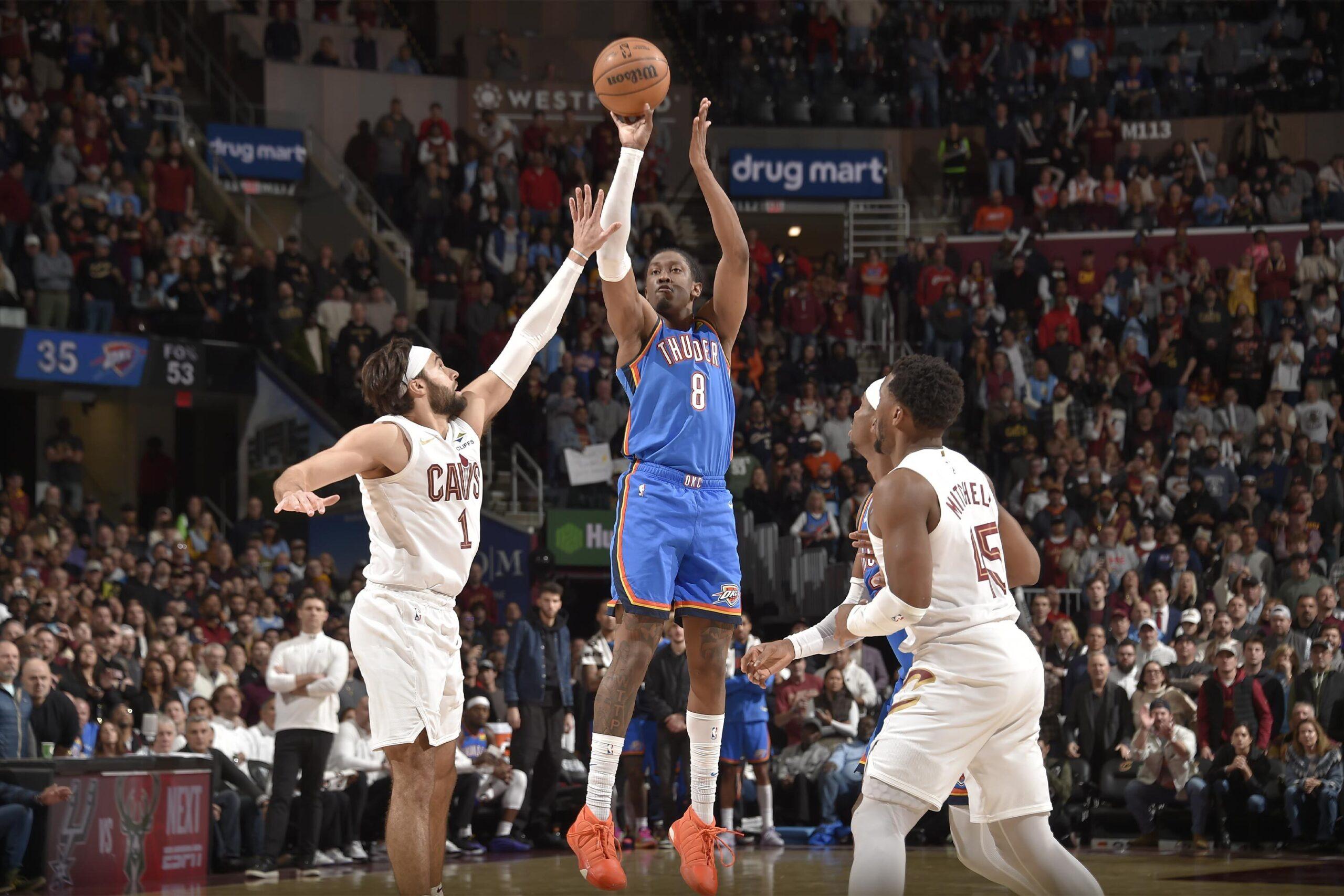
When OKC drafted him 12th in 2022, Williams was still somewhat of an unknown. He wasn’t even the only “J. Williams” on his team, after the Thunder selected center Jaylin Williams 34th that same year. Throughout the predraft process, Jalen and Jaylin were constantly mistaken for each other.
“We were getting tagged in each other’s videos,” says Jaylin, who goes by Jay Will to distinguish himself from J-Dub. “We were both at the draft combine, and we always ended up in the same room. It got to a weird point where we were always in the same room at the same time, and they would ask us our name and they thought we were playing.”
On the court, playing next to a superstar like Gilgeous-Alexander was a perfect situation for Williams, who already knew how to impact the game without scoring. “How else can I help the team?” he’d often ask himself that first year. He was eager to guard the top players in the league, even if, inevitably, they scored on him. “Sometimes people are going to fry you. Sometimes people are going to score,” he says. “That’s what makes the game fun because it’s like, ‘I can go at you, too.’”
J-Dub remembers the exact play when he first got fried. Rookie year. Kevin Durant. In OKC. “Him and D-Book gave me a welcome-to-the-NBA moment,” he says. Durant was stellar and couldn’t miss from the field. “He was talking trash to fans while he was playing. And then I switched off of him, and Book hit two crazy shots [on me] in a row down the stretch.” He remembers another moment: “Klay [Thompson] hit a really tough shot on the baseline,” Jalen says, “and slapped my ass, and he was like, ‘Got you, bro.’”
But it didn’t take long for Jalen to stand out. He fit immediately into what the Thunder were trying to build. “We’re not selling our environment to people when they come in the door,” Daigneault says. “They come in and they’re like, ‘Oh yeah, this is how it should be.’ You should be professional. You should work hard at all parts of the program, not just on the court. You should be competitive inside the team. You should try to be an efficient player.
“[Jalen] is fluent in our vernacular and has been from day one,” Daigneault says.
Williams laughs. It could have been worse; his hero, Kobe, shot four air balls in a postseason game after his rookie season. And sure enough, J-Dub began to find his way, averaging 14.1 points, 4.5 rebounds, 3.3 assists, and 1.4 steals (leading all rookies) while shooting better than 52 percent from the field. A late bloomer all his life, Williams adapted to the NBA game remarkably quickly.
Now in his third season, Williams is emerging as a poster child for a contemporary type of NBA stardom. His ability to do everything well makes him a precious player in a league that is less committed to traditional archetypes and more desperate for playmaking and defense across the positional spectrum. The Thunder deserve credit for identifying the way that sort of player could amplify everyone else on the roster, and Williams deserves credit for molding himself into that sort of player before it garnered this level of attention.
It’s strange for Williams to be in the limelight after so many years of being overlooked. He sees himself in much the same way OKC fans do: as a regular person who journals, loves thrifting, collects vintage tees and action figures, and cherishes home-cooked meals.
It seems safe to say his days of anonymity are over. In three years, Williams has gone from an unheralded prospect to the second-most important player on a championship heavyweight. That brings a new set of challenges that are less about finding his place in the league and more about growing into the best player he can ultimately be. At times during last year’s playoffs, the Thunder needed additional sources of offense beyond SGA. For as valuable as Williams’s Swiss Army knife skill set is, OKC may need him to morph into even more of a scorer for this version of the team to thrive.
Those who have followed Williams’s career are confident he’ll meet the challenge. “He can be whatever he wants to be,” SGA says. “It would be silly to put a ceiling on how good he can be.”
The same goes for the Thunder. At 33-6, OKC has the second-best record in the NBA heading into a rematch against the league-leading Cavaliers. SGA is a top candidate for MVP, and Holmgren is reportedly ramping back up to return to play. Meanwhile, team chemistry has never been better. After games, you can see OKC’s players huddle around the player getting interviewed, wrapping their arms around each other’s shoulders. “Everybody here gets to be themselves. Nobody has to conform to act a certain way or anything,” Holmgren says. “And because of that, we’re all able to kind of be ourselves and enjoy being around each other because everybody brings a different kind of vibe together. And it shows up on the court too.”
Williams feels the same energy. “In order to be a successful player, you have to have teammates that still believe in you,” he says. “That’s reciprocated on their end and my end, which is why I think we’re a very good team because they trust me in certain situations, and I trust them in situations. Being able to bounce that back and forth, I think that’s why we are what we are.”
